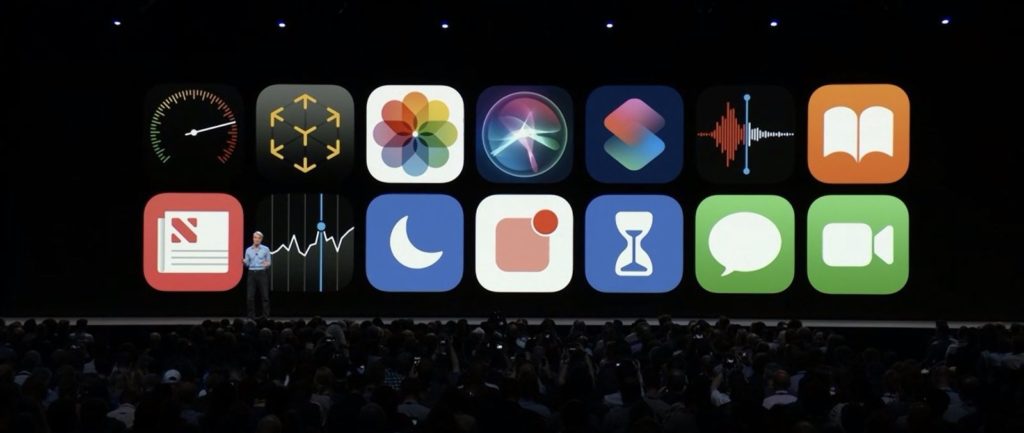- Today, Apple said loudly and clearly that the customer is always right.
- There were more new features for users than there were new tools for developers: screen time limits, monitoring, and reports, grouped notifications, Do Not Disturb at bedtime, Siri shortcuts, new Safari privacy features, performance improvements for previous generation iPhones, and even third-party navigation apps on CarPlay. Apple is forgoing near-term benefits for developers and themselves in favor of a better user experience.
- Apple is drawing a hard line between itself and other companies that rely on consumer data.
- There are now 20M registered iOS developers building applications for 1.3B active devices.

Source: iMore
Democratizing Machine Learning. Apple spent the bulk of its limited developer-centric discussion on new ML tools. Specifically, Create ML on the Mac and Core ML 2 for iOS, which make it easy for developers to build ML techniques into their apps. When thinking about the ML announcements at WWDC, it’s important to note that the keynote is designed to inspire developers and the “state of the union” session (which followed the keynote) shows developers how to actually use these tools. As investors in the space, we’re excited to see Apple making it easy for entrepreneurs to harness the power of ML on Apple’s 1.3B+ device ecosystem.
As investors in the space, we’re excited to see Apple making it easy for entrepreneurs to harness the power of ML on Apple’s 1.3B+ device ecosystem.
No New Hardware. Apple will take some heat for the lack of hardware product announcements, but we did a quick check and found that 11 of the past 19 WWDC keynotes have not included any hardware announcements. We didn’t see a new iPad (which we continue to expect in the coming months), and any discussion of new Beats hardware with Siri integration was nowhere to be found ????♂️.
At the beginning of the keynote, Cook declared that WWDC 2018 was “all about software.” And he kept his promise. iOS, macOS, tvOS, watchOS – each one saw improvements that make those product lines more appealing. In many ways, Apple finished what they started with the software updates announced at WWDC 2017.
ARKit 2: a measurable step forward, but we’re not there yet. We are still believers that AR will transform human interaction, but it will take time. ARKit 2 is a measurable step forward, making it easier for developers to build compelling experiences with the additions of multiplayer sessions (allowing two or more people to share an AR experience) and a new file format (USDZ), which allows you to add AR content to existing media formats. While these two additions will clearly streamline AR development, mobile AR tech still lacks “persistence” (the ability of a virtual object to remain in place after a session has ended), as well as the mapping of the AR cloud (managing virtual data and privacy).
Apple Watch Improvements. Apple Watch is running away with the wearable space. Today, Tim Cook announced Apple Watch grew units by 60% last year (2017). While Apple Watch had a slow start in 2015, it appears to be picking up momentum. Apple doesn’t disclose the number of watches sold, but we estimate, in 2015, the company sold 5.7M, compared to 10.2M in 2016, and 16.1M in 2017. We believe that number will increase by 44% in CY18. We expect the Apple Watch business to grow in the mid-to-low 20% range through 2020, which implies Apple Watch will account for 6% of revenue in 2020 compared to 3% in 2017. Apple Watch is gaining momentum because Apple created the computer-on-your-wrist category allowing for significantly more advanced functionality compared to other wearables. For example, today, Apple announced walkie-talkie, new personal and group fitness features, Siri’s accelerometer integration, and a handful of Universities enabling student IDs on Apple Watch. Apple Watch’s measurable utility lead in the wearable space gives us confidence that the product can account for 31M units in 2020, nearly double the units sold in 2017.
Expect $32B in Apple Developer earnings in 2018. Apple announced that developers have earned over $100B since the App Store launched in 2008. That compares to $86B in earnings at the end of 2017, and $70B a year ago (June 2017). While Apple reported that developer earnings grew just over 30% in 2017, we expect that growth to be closer to 20% in 2018, in line with the overall growth of Services. This implies that developers will earn about $32B this year, a number that we believe is big enough to continue to entice world-class developers to continue to code on iOS and macOS.
Disclaimer: We actively write about the themes in which we invest: virtual reality, augmented reality, artificial intelligence, and robotics. From time to time, we will write about companies that are in our portfolio. Content on this site including opinions on specific themes in technology, market estimates, and estimates and commentary regarding publicly traded or private companies is not intended for use in making investment decisions. We hold no obligation to update any of our projections. We express no warranties about any estimates or opinions we make.
